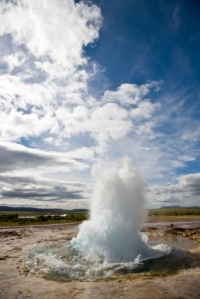
Apparently, we still need to evolve as far as harnessing energy from geothermal technology is concerned. Geothermal plants have been out there for a long time; some were successful and some projects were closed down due to higher costs, leakage problems and other technical snags. Recently, a plan to build the first geothermal plant, designed to generate energy from hot rocks underneath, in the UK was disclosed. The project would power the Eden Project in Cornwall and its nearby community. It will generate electricity for 5,000 homes with the help of steam and hot water produced inside the earth’s surface. It is expected that the plant will be ready in 2012 and will generate 3MW of electricity.
The project

The existing way of capturing the energy from geothermal sources is by way of the “hydrothermal convection” system, where cooled water passes into the crust and finally hot water rises up to the surface. Two holes are drilled, one to pass water into the surface and the second to capture the steam. At the surface, heat exchange is present, which removes most of the heat from the water and helps to drive the turbine. The turbine will power the generator and will convert the energy into electricity. The waste water left will be send directly to offices, homes and other parts of the city.
Geothermal Power: A rough road until now
Many failed geothermal power projects in the past have proved that it is a risky proposition altogether. The major risks involved in the geothermal process are exploration, geothermal resource capacity i.e. the hydrothermal convective system, drilling, financing and plant construction.
Some of the major projects that failed include:
• 400 KW Geothermal power plant at Alaska: During the testing process in 2007, the turbine nozzle filter failed with penetration holes and the turbine was immediately flooded with the debris that was left in the condenser.
• 1 MW power plant at South Australia: Geodynamics, a Brisbane-based company, had operated the geothermal plant at Innamincka, South Australia. While drilling deep inside the hot rocks, a rupture occurred and the steam started escaping from the well, which made it a failed project.
• 250 KW plant at California: In 1921, a geothermal facility started by John D. Grant in the U.S. at the Geysers stream in California could not stand up to the abrasion that was due to the impurities present in the steam. The main reason for this failure was accounted to the bad quality of pipes transporting steam and the turbines that were used to generate electricity.
• Geothermal plant at Switzerland: The plant was unable to generate electricity by pumping water deep into the earth’s surface and was hit by a minor quake, which stopped its working from December 2006.
Future
The opportunities for geothermal power to play an important role in the future will require technical innovations, reduced start-up costs, public education and other energy technologies. Many geothermal systems like fumaroles, hot springs and geysers have been developed in the past. In order to find new hidden geothermal systems, new approaches to exploration are needed. The high risk of drilling has restricted the geothermal exploration. The development of the geothermal plant will depend upon the new discovery and production of water-dominated geothermal fields and even the drilling techniques for reaching them.

